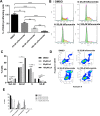The anti-rheumatic drug, leflunomide, synergizes with MEK inhibition to suppress melanoma growth
- PMID: 29423085
- PMCID: PMC5790502
- DOI: 10.18632/oncotarget.23378
The anti-rheumatic drug, leflunomide, synergizes with MEK inhibition to suppress melanoma growth
Erratum in
-
Correction: The anti-rheumatic drug, leflunomide, synergizes with MEK inhibition to suppress melanoma growth.Oncotarget. 2018 Nov 27;9(93):36645. doi: 10.18632/oncotarget.26415. eCollection 2018 Nov 27. Oncotarget. 2018. PMID: 30564304 Free PMC article.
Abstract
Cutaneous melanoma, which develops from the pigment producing cells called melanocytes, is the most deadly form of skin cancer. Unlike the majority of other cancers, the incidence rates of melanoma are still on the rise and the treatment options currently available are being hindered by resistance, limited response rates and adverse toxicity. We have previously shown that an FDA approved drug leflunomide, used for rheumatoid arthritis (RA), also holds potential therapeutic value in treating melanoma especially if used in combination with the mutant BRAF inhibitor, vemurafenib. We have further characterized the function of leflunomide and show that the drug reduces the number of viable cells in both wild-type and BRAFV600E mutant melanoma cell lines. Further experiments have revealed leflunomide reduces cell proliferation and causes cells to arrest in G1 of the cell cycle. Cell death assays show leflunomide causes apoptosis at treatment concentrations of 25 and 50 µM. To determine if leflunomide could be used combinatorialy with other anti-melanoma drugs, it was tested in combination with the MEK inhibitor, selumetinib. This combination showed a synergistic effect in the cell lines tested. This drug combination led to an enhanced decrease in tumor size when tested in vivo compared to either drug alone, demonstrating its potential as a novel combinatorial therapy for melanoma.
Keywords: MEK inhibitors; combinatorial therapy; leflunomide; melanoma; selumetinib.
Conflict of interest statement
CONFLICTS OF INTEREST The authors declare no potential conflicts of interest.
Figures





Similar articles
-
Inhibitors of pan-PI3K Signaling Synergize with BRAF or MEK Inhibitors to Prevent BRAF-Mutant Melanoma Cell Growth.Front Oncol. 2015 Jun 16;5:135. doi: 10.3389/fonc.2015.00135. eCollection 2015. Front Oncol. 2015. PMID: 26137449 Free PMC article.
-
Palbociclib synergizes with BRAF and MEK inhibitors in treatment naïve melanoma but not after the development of BRAF inhibitor resistance.Int J Cancer. 2018 May 15;142(10):2139-2152. doi: 10.1002/ijc.31220. Epub 2018 Jan 3. Int J Cancer. 2018. PMID: 29243224
-
Differential expression of ABCB5 in BRAF inhibitor-resistant melanoma cell lines.BMC Cancer. 2018 Jun 22;18(1):675. doi: 10.1186/s12885-018-4583-3. BMC Cancer. 2018. PMID: 29929490 Free PMC article.
-
MEK Inhibitors in the Treatment of Metastatic Melanoma and Solid Tumors.Am J Clin Dermatol. 2017 Dec;18(6):745-754. doi: 10.1007/s40257-017-0292-y. Am J Clin Dermatol. 2017. PMID: 28537004 Review.
-
BRAF and MEK inhibition in melanoma.Expert Opin Drug Saf. 2015 Apr;14(4):559-70. doi: 10.1517/14740338.2015.1011618. Epub 2015 Feb 4. Expert Opin Drug Saf. 2015. PMID: 25648338 Review.
Cited by
-
UVB-induced DHODH upregulation, which is driven by STAT3, is a promising target for chemoprevention and combination therapy of photocarcinogenesis.Oncogenesis. 2019 Sep 24;8(10):52. doi: 10.1038/s41389-019-0161-z. Oncogenesis. 2019. PMID: 31551419 Free PMC article.
-
Teriflunomide - The common drug with underestimated oxygen - Dependent anticancer potential.Biochem Biophys Rep. 2021 Sep 23;28:101141. doi: 10.1016/j.bbrep.2021.101141. eCollection 2021 Dec. Biochem Biophys Rep. 2021. PMID: 34611552 Free PMC article.
-
HDAC Inhibition Induces Cell Cycle Arrest and Mesenchymal-Epithelial Transition in a Novel Pleural-Effusion Derived Uterine Carcinosarcoma Cell Line.Pathol Oncol Res. 2021 Mar 26;27:636088. doi: 10.3389/pore.2021.636088. eCollection 2021. Pathol Oncol Res. 2021. PMID: 34257602 Free PMC article.
-
AhR and Cancer: From Gene Profiling to Targeted Therapy.Int J Mol Sci. 2021 Jan 13;22(2):752. doi: 10.3390/ijms22020752. Int J Mol Sci. 2021. PMID: 33451095 Free PMC article. Review.
-
Drug Repurposing and Nanotechnology for Topical Skin Cancer Treatment: Redirecting toward Targeted and Synergistic Antitumor Effects.ACS Pharmacol Transl Sci. 2025 Jan 23;8(2):308-338. doi: 10.1021/acsptsci.4c00679. eCollection 2025 Feb 14. ACS Pharmacol Transl Sci. 2025. PMID: 39974652 Review.
References
-
- Ward EM, Thun MJ, Hannan LM, Jemal A. Interpreting cancer trends. Ann N Y Acad Sci. 2006;1076:29–53. - PubMed
-
- Robert C, Schachter J, Long GV, Arance A, Grob JJ, Mortier L, Daud A, Carlino MS, McNeil C, Lotem M, Larkin J, Lorigan P, Neyns B, et al. Pembrolizumab versus Ipilimumab in Advanced Melanoma. N Engl J Med. 2015;372:2521–2532. - PubMed
LinkOut - more resources
Full Text Sources
Other Literature Sources
Research Materials

